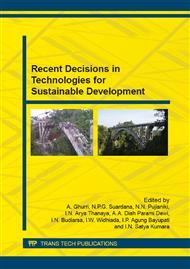p.9
p.17
p.24
p.30
p.36
p.41
p.47
p.53
p.59
Mechanical Strength of Hydraulic Binder Made by Blending Type I Portland Cement and Pozzolan
Abstract:
The mechanical strength of hydraulic binder made by blending type I Portland cement (PC) and pozzolan has been examined at the age of 3, 7, 14, 28 and 90 days.The mechanical strength test was realized by using mortar specimens measuring 40x40x160 mm according to NF EN 196-1. The mix proportion of mortarwas 0.5 water :1.0 hydraulic binder : 3.0 sand, by weight.The hydraulic binder was a mixture of 80% PC and 20% pozzolan. Five types of pozzolan were used in this study: two natural pozzolan and three artificial pozzolan. As a control, it was made a mortar havingthe same proportion except that the hydraulic binder was 100% PC. The test result showsthat all of pozzolan present a good pozzolanic reactivity. At 3 days,the strength of the mortar with blended binder (MBB) is lower than the strength of the control mortar (CTM). At that time, the flexural tensile strength and the compressive strength of the MBB rangerespectively from 5.23 to 6.81 MPa and from 13.61 to 18.37 MPa, whereas the CTM strength has reached 7.30 MPa and 27.92 MPa. The MBB strength increasesand it canachieve or even exceed the CTM strengthwith increasing age of hydration. In fact, at 90 days, the flexural tensile strength and the compressive strength ofMBB can reach about 10.08 to 11.06 MPa and 49.69 to 54.17 MPa respectively. In this period of hydration, the flexural tensile strength and the compressive strength of CTM are only 10.13 MPa and 49.00 MPa. The different development of the mechanical strength of MBB could be stronglyrelated to the chemical content of the pozzolan used, especially, reactive silica and reactive alumina.
Info:
Periodical:
Pages:
36-40
Citation:
Online since:
July 2015
Authors:
Price:
Сopyright:
© 2015 Trans Tech Publications Ltd. All Rights Reserved
Share:
Citation:


